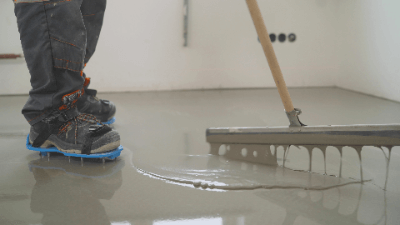What Is Leveling Compound?

Leveling Compound is a building material used to prepare the base of a concrete floor.
It is a slightly viscous liquid that spreads smoothly over a floor surface when poured onto it. When installing, it is simply poured onto the floor surface and lightly smoothed down with a paddle or similar tool.
The fluidity of the material naturally spreads horizontally on the floor surface, making the concrete floor surface smooth. Leveling Compound is relatively easy to apply and provides a smooth finish equal to or better than a conventional trowel finish.
Uses of Leveling Compound
Leveling Compound is a construction material that adjusts the base of a concrete floor. Therefore, they are useful for adjusting the subflooring of facilities used by humans, such as condominiums, buildings, schools, and hospitals, as well as facilities where heavy objects are moved, such as factories and parking lots where heavy objects such as forklifts are used.
It is also suitable for adjusting the underlayment of floors to be waterproofed, so it is used for adjusting the underlayment of floors in food factories and kitchens that use a lot of water. They are also used in both new construction and renovation work as ground preparation to form a smooth surface prior to the installation of tiles and other floor coverings and the application of waterproofing paint on rooftops.
Principle of Leveling Compound
Leveling Compound has the characteristic of flowing smoothly with its own fluidity, so that a uniform flat surface can be formed simply by lightly smoothing it with a trowel or trowel. In many flooring projects, the floor finish material is applied after the surface preparation. If the surface is not smooth, the unevenness of the floor will be noticeable due to light reflection after the floor finish material is applied.
In the past, mortar was often used. When mortar is used for surface preparation, water, cement, and sand are mixed together, and then the craftsman manually applies the mixture to the floor with a trowel, little by little. Therefore, the smoothness of the surface is largely dependent on the skill of the craftsman, and there was a disadvantage that the quality tended to vary.
However, with Leveling Compound, a smooth surface can be formed simply by lightly smoothing the surface with a trowel or paddle, thus forming a smooth base without depending on the skill of the craftsman.
Types of Leveling Compounds
Leveling Compounds can be broadly classified into two types: gypsum-based and cement-based.
1. Gypsum-Based
Gypsum has the property of slightly expanding in a hydration reaction and then not contracting. Therefore, gypsum-based Leveling Compounds, whose main component is gypsum, have the effect of increasing dimensional stability and reducing the occurrence of lifting and cracking.
2. Cementitious Materials
The quality standards for cementitious leveling materials are set higher than those for gypsum leveling materials in terms of compressive strength and strength of substrate adhesion and surface adhesion, as stated in JASS, the standard specifications for building construction by the Architectural Institute of Japan. Therefore, there are many high-strength products available, and they are also characterized by their resistance to water after curing.
Other Information on Leveling Compound
1. Installation Method of Leveling Compound
Surface Preparation
Clean the floor surface to remove sand and dust. At this time, also remove any fragile parts of the floor. It is also very important to prevent leakage around the installation area to prevent material from flowing outside of the installation area. Mortar is often used for this purpose.
The next step is to apply a primer that improves the adhesion of the material to the floor surface and allow it to dry. The treatment must be applied and allowed to dry at least one day prior to pouring.
Mixing
Leveling Compound is put into a container containing the specified amount of water and kneaded with a hand mixer or grout mixer.
Pouring
The kneaded material is poured over the floor until the desired thickness of the Leveling Compound layer is achieved. The kneaded material flows smoothly on its own, but ripples may form on the surface, and air bubbles generated by the floor (frame) may remain in the applied layer.
Curing
The next step is the curing process for drying. At this point, rapid drying should be avoided. Close windows to prevent wind from blowing. By closing windows, ripples caused by wind on the surface can be prevented.
If the finish is applied before the coating layer is dry enough, the moisture in the coating layer will cause the finish to peel off. The standard moisture content is about 5% to be able to apply the finishing material.
2.Comparison With Mortar
When Leveling Compound is applied, it dries in about one day, and the construction period is shorter than that of mortar, which requires several days to dry. In addition, construction may be less expensive than conventional flooring materials.
Comparing the cost of materials alone, mortar is less expensive. However, costs may increase due to the need to unload water, cement, and sand, which takes several days to dry and lengthens the construction period.